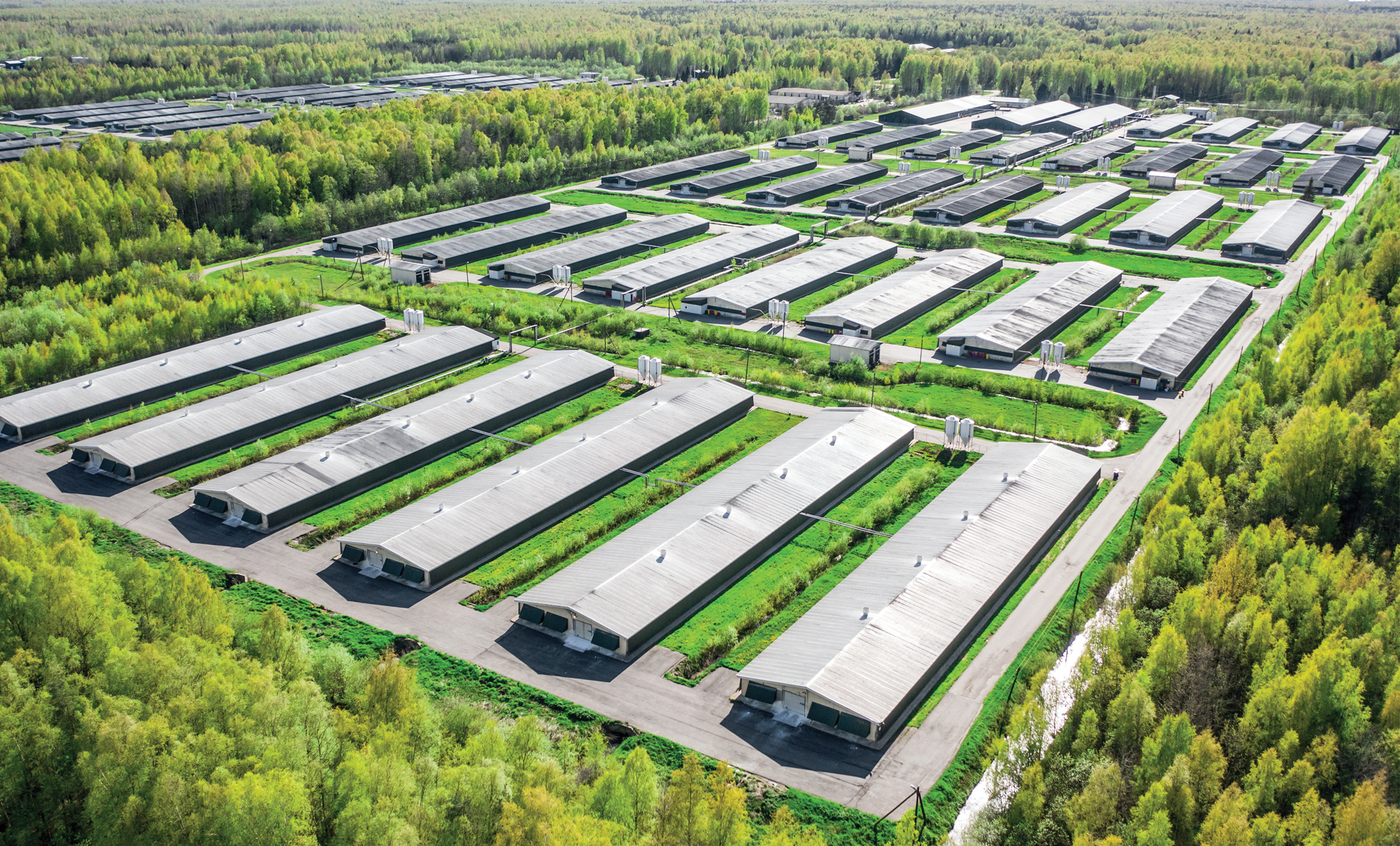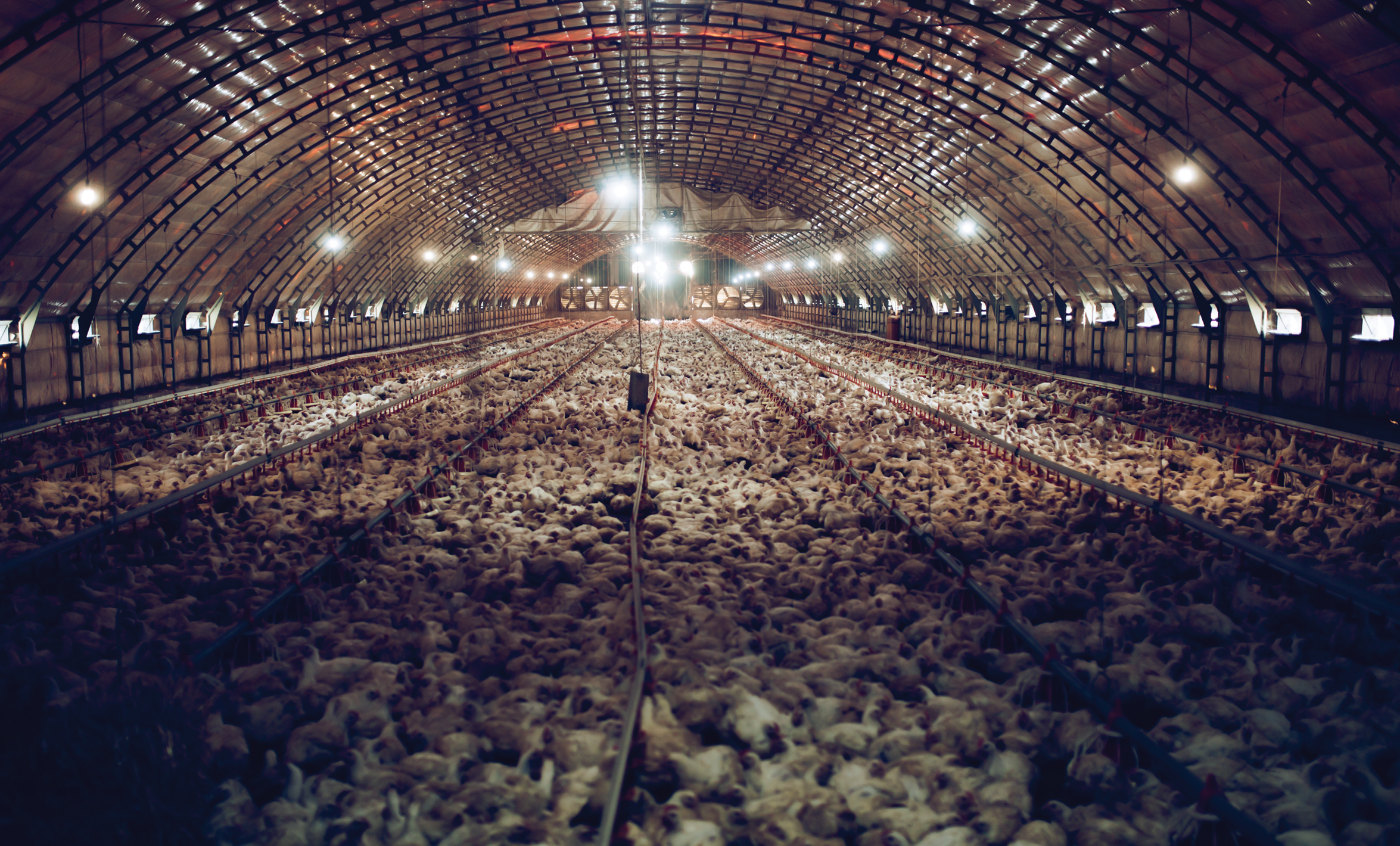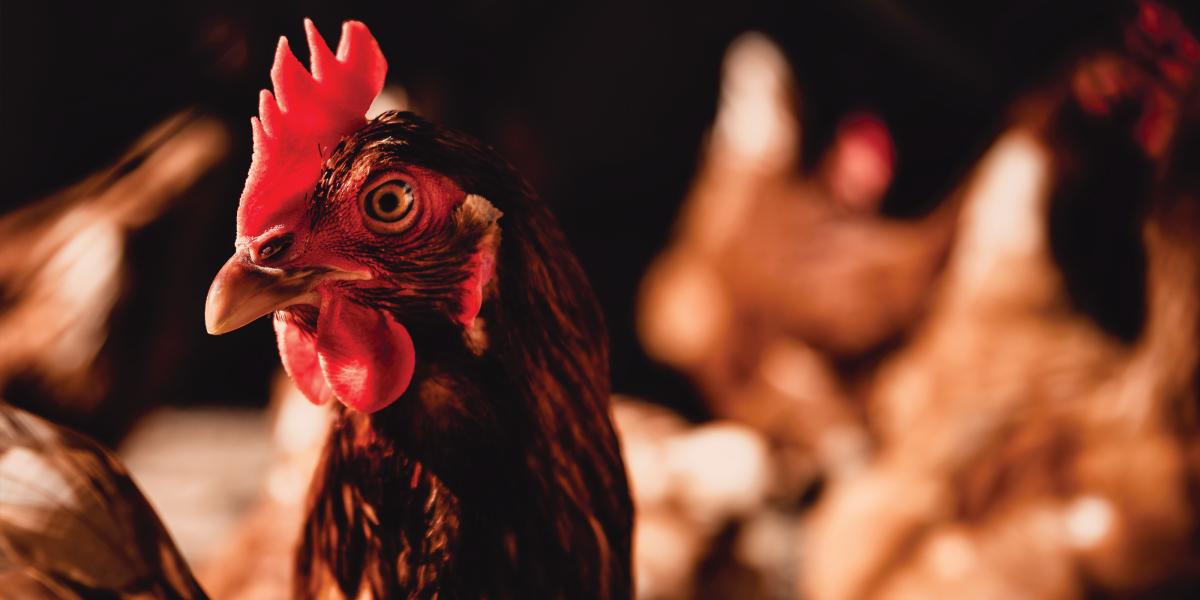The Many Costs of Cheap Chicken
Industrial food animal production exploits workers, poisons water sources, and promotes the transmission of antibiotic-resistant superbugs. Is there a better way?
Broken clouds, dripping humidity, and a heat index of 101°F droop across Delaware’s flat and sandy eastern shore on a midmorning in late June. At the southern tip of Georgetown in Sussex County, the Hispanic evangelical church Iglesia de Dios de la Profecia stands in a sweltering parking lot surrounded by open fields of corn and soy. In the church’s cool, brightly lit all-purpose room, Pastor Anastacio Matamoros, some congregants, and local community members sit with Bloomberg School researchers on folding metal chairs.
“We have come to hear what you have to say, what your concerns and experiences are,” says associate professor of Environmental Health and Engineering Christopher Heaney, PhD, MS. He and his colleagues are part of a $5.6 million National Institute of Environmental Health Sciences grant engaging local citizens to help identify links between environmental exposures and adverse health outcomes. Today, they want to hear from area residents who work for or live near the chicken growing and processing facilities that generate $7 billion and 29,000 jobs across the small state.
Community activist Maria Payan of the Sussex Health and Environmental Network shares a Google map of the surrounding area. It’s peppered with blue dots. Each typically represents an active poultry house twice the length of a football field and 60 feet wide, and crowds in 50,000 birds. Enormous fans at the end of each structure that blow air through the building also spew significant quantities of volatile organic compounds along with ammonia, bacteria, and fungi. This airborne “poultry dust”—made up of bird droppings, feathers, dander, and other materials—results in occupational asthma cases at twice the national average across all industries.
Next, a retired couple shares their experience living within sight of a major chicken processing facility, where the birds are killed, plucked, butchered, and packaged for supermarket sales. The wells supplying clean water to their and their neighbors’ homes are contaminated with nitrates from the processing plant. High nitrate exposure has been linked to ill health effects ranging from increased heart rate to nausea and abdominal cramping, with some studies suggesting an increased cancer risk, especially gastric cancer. They can no longer drink the water from their taps. As part of a 2021 legal settlement, the couple and their neighbors rely on bottled water provided by the chicken processor for all their drinking and cooking needs.
Later, Bloomberg School researchers and community members travel to Ebenezer Haitian Seventh-Day Adventist Church in nearby Seaford. Church member Emanie Dorival, a registered nurse and founder and CEO of Ephphatha Medical Care Services, explains the brutal demands on the Haitian community members who work in local chicken processing plants. They receive little training yet must cut 14 pieces of chicken per minute or face penalties. “I have seen hundreds of work-related injuries. But it’s hard to get them to report violations,” says Dorival. “Many are undocumented workers, and they fear losing their jobs.”
Air unfit for breathing. Water unsafe for drinking. Jobs that exploit marginalized workers. These and a host of other insults to human health are among the many impacts of industrial food animal production, or IFAP.

One day in 1923, in Ocean View, Delaware, farmer Cecile Steele ordered her customary 50 laying hens for the season. But 500 chicks arrived. It was a take-it-or-leave-it situation, according to industry trade group Delmarva Chicken Association, so Steele had her handyman build an 8-foot by 12-foot shed that she filled with the chickens and equipped with a woodburning stove. Eighteen weeks later, she had 387 surviving birds weighing about two-and-a-half pounds apiece. She sold them at 62 cents per pound (the equivalent of more than $11 per pound today) and made a small fortune.
Steele’s success evolved into the sprawling, global IFAP system that supplies almost all of our meat, eggs, and dairy today. The number of chickens, cows, pigs, and turkeys in the U.S. food system exceeded 10 billion in 2022, up from 5.2 billion animals in 1987, according to the USDA’s Census of Agriculture. A snapshot in time reveals the enormous consumption these numbers reflect: the National Chicken Council, the industry’s trade association, announced that Americans devoured 1.45 billion chicken wings while watching Kansas City and San Francisco battle in the 2024 Super Bowl.
Yet all this plenitude comes at steep costs that are largely invisible to the average consumer, says Keeve Nachman, PhD ’06, MHS ’01, the Robert S. Lawrence Professor in Environmental Health and Engineering. “There are planetary, human, animal, and ecological costs associated with producing that cheap pound of chicken that are not reflected in what you pay at the grocery store,” says Nachman, who is also associate director of the Center for a Livable Future.
In the U.S., most of those costs stem from the country’s dominant model of animal production: the concentrated animal feeding operation, or CAFO. These came into use in the 1950s with chickens and in the 1970s with swine and cattle. The EPA defines large CAFOs as operations confining 1,000 or more “animal units”—comprising 1,000 beef cows or 700 dairy cows, for example, or 2,500 hogs, or 125,000 chickens—indoors for at least 45 days at a time. More than 21,000 such CAFOs were operating in the U.S. in 2020, according to the EPA.
Raising large numbers of animals together in a confined space presents two related problems: food in and waste out. Federal subsidies support the production of soybeans and especially corn, which accounts for the vast bulk of total feed grain production. Globally, a third of all cropland is used to grow animal feed, according to the UN Food and Agriculture Organization (FAO). Devoting large areas of arable land to growing feed for animals deepens our reliance on corn and soy monocultures, with the associated problems of soil degradation, pesticide overuse, and biodiversity loss—while creating competition over a limited area that could instead be used to grow food directly for people.
Waste out is an especially difficult challenge. Livestock and poultry held in CAFOs produce 1.4 billion tons of manure annually—which, unlike human waste, is not treated. Poultry houses are typically cleaned once a year to remove manure, which is then stored in sheds or on open pads or in fields until it’s applied as fertilizer. Cattle and swine excrement, however, is simply pumped into large open pits euphemistically called “lagoons.” These methods often fail to contain the waste. After Hurricane Florence ravaged the swine-producing areas of North Carolina in 2018, for instance, the New York Times reported that more than 100 lagoons full of pig waste were either nearly or already overflowing and releasing untreated waste into local streams and waterways.
This is just one of the risks to human health, say critics of the CAFO system. Extreme concentrations of any single species provide a rich breeding ground for dangerous pathogens. “Imagine a classroom with a capacity for 200 people, and it’s packed, and you introduce someone infected,” posits Meghan Davis, DVM, PhD ’12, MPH ’08, an associate professor in EHE. “There’s a lot of contact, a lot of transmission.
“The same thing is true when you think about an industrial scale animal production facility where you’ve packed in all these animals and then introduce an infectious agent,” says Davis, who previously worked as a veterinarian caring for dairy cattle in Lebanon County, Pennsylvania. “It spreads like wildfire.”
To mitigate this risk, CAFOs have relied on an abundant use of antibiotics—both as prophylaxis and, until recently, to promote animal growth, a practice that the FDA began phasing out a decade ago but still persists. Recent data show that about 65% of medically important antibiotics currently sold in the U.S. go to food animal production. But frequent use of antibiotics among food animals directly endangers human lives. Past indiscriminate use of antibiotics in food animals has greatly increased the prevalence of antibiotic-resistant superbugs such as methicillin-resistant Staphylococcus aureus (MRSA), and, according to a 2019 CDC report, has led to an estimated 2.8 million annual infections and as many as 160,000 excess deaths. And that’s just bacteria. High concentrations of animals—especially birds—provide ample opportunity for viruses to mutate and spread through animal species, as evidenced by the highly pathogenic H5N1 avian influenza that has infected U.S. dairy cows and agricultural workers, as well as harbor seals, raccoons, deer mice, mountain lions, and other mammals. Experts are concerned about a pandemic of the disease, which has been reported in 23 countries since 1997.

Thanksgiving with no turkey on the menu? For most Americans, it would be inconceivable. Food is more than sustenance; it is deeply cultural. And that includes Americans’ love of chicken wings and hamburgers, bacon and turkey legs, ice cream and three-egg omelets. The U.S. is tied with Portugal for highest overall meat consumption per person, coming in at 328 pounds a year, according to FAO.
“Our perspective is that while we certainly need significant reform, it’s not reasonable to advocate for ending all meat production,” says Center for a Livable Future senior program officer Patti Anderson, PhD ’14, MPH ’09. “This is particularly important because there are a lot of settings, especially outside the U.S., where animal-sourced foods can be produced sustainably and are critical to diet.” In calorie-challenged communities, for instance, goats and pigs can forage on marginal lands but provide much-needed protein to human diets. In the U.S., however, the challenge is bringing changes necessary for long-term sustainability to an entrenched system defended by rich and powerful interests.
The most effective leverage, as is so often the case, may lie in the power of the purse. “We can’t just flip a switch and start producing food the way we need to, but we can transition there,” says Nachman. “One powerful tool for moving in that direction is through procurement.” Large institutions such as schools and universities, governments, and the military are potentially effective agents of change. “If we can incentivize large institutions to source foods that are produced in a way that respects people, the planet, and animals, that can bring change,” he says. “And we can nudge—you know, encourage these institutions to put plant-based options front and center so that people default to the healthier and more sustainable choice.” In a buffet or cafeteria line, for instance, large platters of grains and legumes could be supplemented with animal protein side dishes and alternative protein meat substitutes (see sidebar) that would share equal billing with the traditional choices.
Another avenue may be to let the sun shine in. “One of the pillars of change has to be around transparency,” says Anderson. “There is a deep, ‘out of sight, out of mind’ vein to how we raise and process food animals in this country. When you get everything nicely packaged at the grocery store, you don’t have to think about how it got there.” Consumers can’t make good choices about what they eat unless they are actually informed. While package labeling that identifies eggs as coming from “free range” chickens is a start, USDA regulations do not require that those chickens spend time outside. Clear and accurate definitions of terms need to be determined and enforced, she says.
Prioritizing animal welfare could be yet another way forward, argues Alan Goldberg, PhD, an EHE professor emeritus who worked on a 2008 CLF and Pew Charitable Trusts report that examined the U.S. IFAP system. “It was a life-changing experience,” says Goldberg, who founded the Center for Alternatives to Animal Testing at the School but had no prior experience with food animal agriculture. “I came away convinced that animal food systems can be intensified without being cruel.” He believes large and centralized animal farms can be humane. What’s missing, he says, is the 8,000-year-old agricultural animal tradition of husbandry, of proper care of and attention to farm animals. (“The rise of confinement agriculture in the 20th century broke this ancient contract,” he says.) Goldberg believes that raising standards of animal welfare through regulation—“providing for the animal to be able to express its natural behavior, essentially providing what the animal needs and what the animal wants”—would address most of the negative human health consequences of IFAPs.
A change of customer behavior here, some additional transparency and greater respect for animals there, adjustments to regulations, and enforcement of environmental rules regulating chemical and biological discharges already in place—some combination of these and similar approaches could bring about real and sustainable change, experts say.
“It’s about helping people understand that our current system of cheap food is actually not so good for them,” says Adam Sheingate, PhD, a professor at the Krieger School of Arts & Sciences who specializes in the politics of food and agriculture. “Whether it’s leading to diet-related disease, or increasing the risks of the next pandemic, or impacting people in rural areas who live near these operations, or the way air and water is seriously compromised, or the incredibly large volume of antibiotics used, these are the issues that matter to people,” says Sheingate, “We need to bring them to the personal level. That’s how we’ll get people to understand not just the science behind these things, but the policies that we need to change.”
